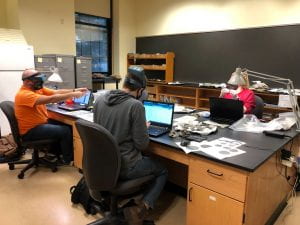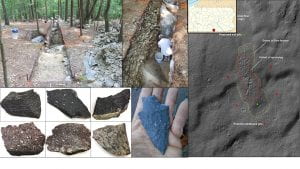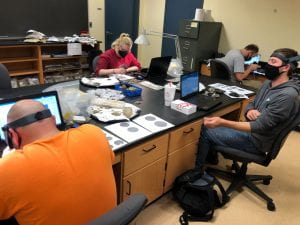Several undergraduate and graduate students are working in the IUP Archaeology lab processing thousands to rhyolite flakes excavated from the Green Cabin quarry site, located in Adams County, PA, on the hillslopes of South Mountain, just east of the Carbaugh Run Natural Area. Green Cabin is one of hundreds of quarry loci where rhyolite for making stone tools was quarried prehistorically in the South Mountain region.
The Precambrian-aged rhyolite in South Mountain originated as lava over 500 million years ago. About 250 million years ago, this lava was altered by heat and pressure associated with mountain building resulting from the collision of North America and Africa. This process resulted in a strong, fine-grained, and intergranular texture conducive to knapping into stone tools. Rhyolite varies widely in color and texture, sometimes even within one quarry location. During the Archaic and Woodland cultural periods, Native Americans quarried for high-quality material in pits measuring approximately 6-8 feet in depth and 20 feet in diameter. Today, the quarry pits appear as subtle depressions that have been backfilled prehistorically by the excavation of adjacent pits, as well as historically by erosion and vegetative debris.
 What has long puzzled archaeologists is why prehistoric people went to so much work to dig pits down to bedrock when it could have been more easily collected from the surface. The other question of interest is why they quarried in some locations and not others where rhyolite outcrops. In order to help answer these questions, and with a permit from the PA SHPO and DCNR, Paul Marr of Shippensburg University began excavating the Green Cabi
What has long puzzled archaeologists is why prehistoric people went to so much work to dig pits down to bedrock when it could have been more easily collected from the surface. The other question of interest is why they quarried in some locations and not others where rhyolite outcrops. In order to help answer these questions, and with a permit from the PA SHPO and DCNR, Paul Marr of Shippensburg University began excavating the Green Cabi n site in 2020. Thousands of flakes and debitage were recovered from 3 pits approximately a meter deep each.
n site in 2020. Thousands of flakes and debitage were recovered from 3 pits approximately a meter deep each.
Students are conducting a lithic and geologic analysis of the material. This includes measuring the size of the flakes, determining the type of flake, as well as describing the geology in terms of color, texture, volcanic structures and phenocrysts (i.e., large crystals of quartz and potassium feldspar embedded in the fine-grained groundmass).
 Usually, quarry lithics exhibit evidence for early-stage reduction: large flakes with a lot of weathering rind on them—this cortex must be removed in order to evaluate the suitability of the stone for knapping, and to reduce the initial size of cobbles for transport elsewhere for further reduction. But at Green Cabin, we were surprised to find a large proportion of small, later stage reduction flakes, suggestion that more reduction was happening at this quarry then one would expect.
Usually, quarry lithics exhibit evidence for early-stage reduction: large flakes with a lot of weathering rind on them—this cortex must be removed in order to evaluate the suitability of the stone for knapping, and to reduce the initial size of cobbles for transport elsewhere for further reduction. But at Green Cabin, we were surprised to find a large proportion of small, later stage reduction flakes, suggestion that more reduction was happening at this quarry then one would expect.
The answer may lie partly in the unique geologic setting of Green Cabin itself. Marr notes several anomalous features: the site sits on a mid-slope bench rather than a ridgetop like most of the quarries; there are no outcrops of similar rhyolite within several hundred meter; and it is covered by a thick layer of colluvium, such that bedrock is very deep here—the prehistoric miners were not digging to bedrock in this location. Marr argues that this flow of material plucked fractured bedrock from upslope and moved it downhill, making quality rhyolite available near the surface.
Work is ongoing and is expected to continue into the spring semester. We also anticipate comparing the material from Green Cabin to material excavated at ridgetop quarry sites in the region. As we increase our sample size and see a wider array of material from other sites, we hope to be able to answer some of the questions related to selection criteria, quarry location, and why the quarried material was reduced further here than at other quarry locations.
For more information visit: https://www.iup.edu/anthropology/research/antiquity-of-the-south-mountain-landscape.htmlv